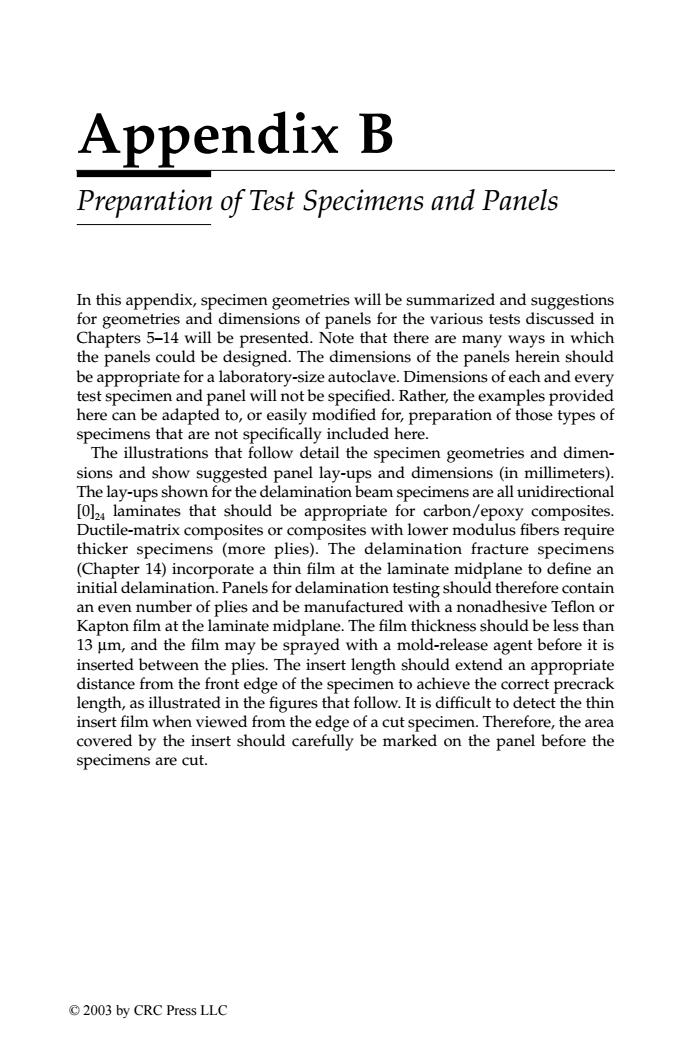正在加载图片...

Appendix B Preparation of Test Specimens and Panels In this appendix,specimen geometries will be summarized and suggestions for geometries and dimensions of panels for the various tests discussed in Chapters 5-14 will be presented.Note that there are many ways in which the panels could be designed.The dimensions of the panels herein should be appropriate for a laboratory-size autoclave.Dimensions of each and every test specimen and panel will not be specified.Rather,the examples provided here can be adapted to,or easily modified for,preparation of those types of specimens that are not specifically included here. The illustrations that follow detail the specimen geometries and dimen- sions and show suggested panel lay-ups and dimensions(in millimeters). The lay-ups shown for the delamination beam specimens are all unidirectional [0]2 laminates that should be appropriate for carbon/epoxy composites. Ductile-matrix composites or composites with lower modulus fibers require thicker specimens (more plies).The delamination fracture specimens (Chapter 14)incorporate a thin film at the laminate midplane to define an initial delamination.Panels for delamination testing should therefore contain an even number of plies and be manufactured with a nonadhesive Teflon or Kapton film at the laminate midplane.The film thickness should be less than 13 um,and the film may be sprayed with a mold-release agent before it is inserted between the plies.The insert length should extend an appropriate distance from the front edge of the specimen to achieve the correct precrack length,as illustrated in the figures that follow.It is difficult to detect the thin insert film when viewed from the edge of a cut specimen.Therefore,the area covered by the insert should carefully be marked on the panel before the specimens are cut. ©2003 by CRC Press LLCAppendix B Preparation of Test Specimens and Panels In this appendix, specimen geometries will be summarized and suggestions for geometries and dimensions of panels for the various tests discussed in Chapters 5–14 will be presented. Note that there are many ways in which the panels could be designed. The dimensions of the panels herein should be appropriate for a laboratory-size autoclave. Dimensions of each and every test specimen and panel will not be specified. Rather, the examples provided here can be adapted to, or easily modified for, preparation of those types of specimens that are not specifically included here. The illustrations that follow detail the specimen geometries and dimensions and show suggested panel lay-ups and dimensions (in millimeters). The lay-ups shown for the delamination beam specimens are all unidirectional [0]24 laminates that should be appropriate for carbon/epoxy composites. Ductile-matrix composites or composites with lower modulus fibers require thicker specimens (more plies). The delamination fracture specimens (Chapter 14) incorporate a thin film at the laminate midplane to define an initial delamination. Panels for delamination testing should therefore contain an even number of plies and be manufactured with a nonadhesive Teflon or Kapton film at the laminate midplane. The film thickness should be less than 13 µm, and the film may be sprayed with a mold-release agent before it is inserted between the plies. The insert length should extend an appropriate distance from the front edge of the specimen to achieve the correct precrack length, as illustrated in the figures that follow. It is difficult to detect the thin insert film when viewed from the edge of a cut specimen. Therefore, the area covered by the insert should carefully be marked on the panel before the specimens are cut. TX001_AppB_Frame Page 215 Saturday, September 21, 2002 5:12 AM © 2003 by CRC Press LLC